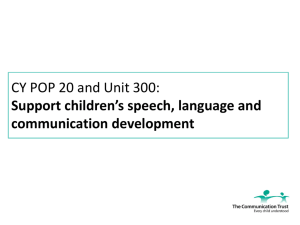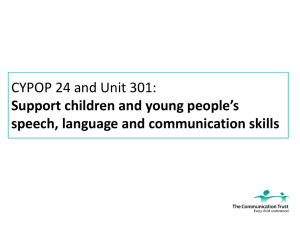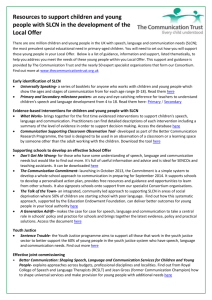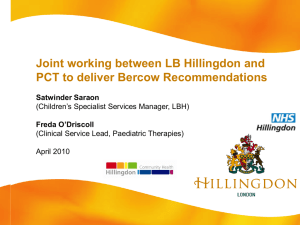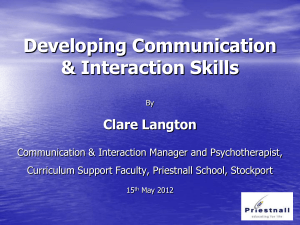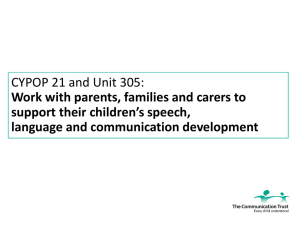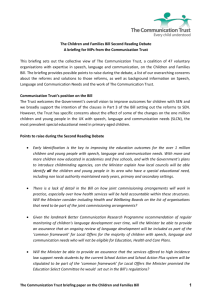Tutor PowerPoint
advertisement
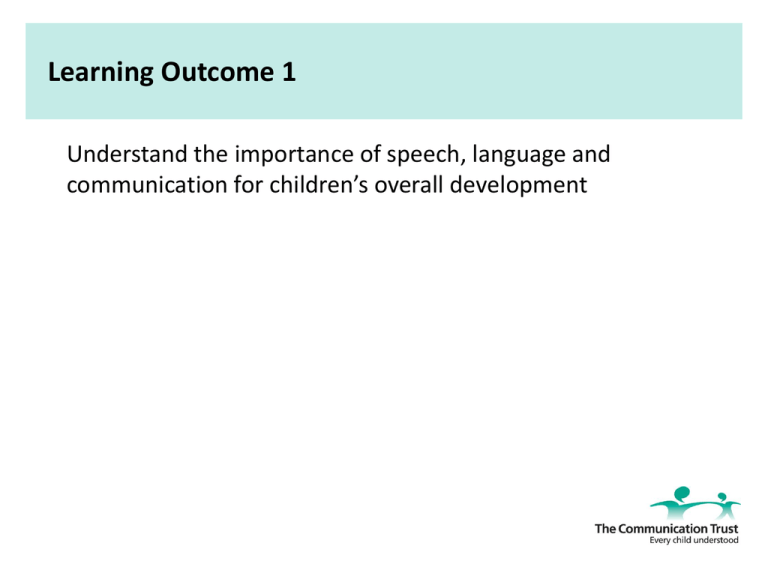
Learning Outcome 1 Understand the importance of speech, language and communication for children’s overall development A simple model: What is speech, language and communication? Children put together what they have heard, and UNDERSTAND Children plan and organise what they will say Children use words to share meaning - TALKING Children hear, attend and listen Children make and use sounds to form words SPEECH Using language to interact with other people – COMMUNICATION Children have to want, need and be confident to communicate Activity 1a: What are speech, language and communication? • In small groups, use the cut out cards and decide if they are speech, language or communication skills • There may be differences of opinion and some might overlap • Feed back to the whole group and discuss your answers. Activity 1a: Speech, language or communication? Babbles Puts his arms up when he’d like you to pick him up Says ‘teddy gone’ Smiles at you Asks for a drink Tells a story Answers a question Takes turns in conversation Follows a story Says that spider starts with ‘s’ Gives you the right toy when you ask for the big teddy Says ‘tat’ for cat Activity 1a: Possible answers Speech Language Communication Babbles Says ‘teddy gone’ Takes turns in conversation Tells a story Puts his arms up when he’d like you to pick him up Says ‘tat’ for cat Says that spider starts with ‘s’ Asks for a drink Answers a question Follows a story Gives you the right toy when you ask for the big car Smiles at you Speech is… The sounds we use for talking As well as the sounds we use, it also includes factors such as: o fluency o volume o intonation and stress on different words o pitch Language includes… Understanding and talking use the following: • Words (vocabulary) and their meanings • How words go together – their order and how this can change meanings (e.g. the difference between statements and questions) • Grammar – for example how word endings change meanings (e.g. past tense) • Sentences joining together to make sense – narratives, stories we share with each other • Higher level skills such as reasoning, inference Communication involves… • Non-verbal communication – for example body language, facial expression, eye-contact, gesture and signing • Conversational skills and rules – for example listening, turn-taking, knowing when and how to start (and finish) talking, how to change topic and using language in different ways. Speech, Language and Communication Needs (SLCN) • Most children follow the expected pattern of development for their speech, language and communication at the expected times. Some, however, do not. These children are described as having speech, language and communication needs (SLCN). SLCN: Quick quiz 1. How many children have SLCN? 1. Around 10% of all children have long-term SLCN 2. Why might children have SLCN? 2. Many different factors e.g. − − − − − − − − In areas of social disadvantage, 50% or more may have delayed language Hearing difficulties Learning difficulties Autism Cleft palate Limited stimulation Poor adult modelling and interaction For some, we don’t know First steps in identifying SLCN Speech • Does the child make the sounds you’d expect for their age? • Can you understand the child’s speech as you would expect for their age? Language • Does the child understand the words, information, questions and stories you would expect for their age? • Does the child use the words and the length of sentence you would expect? Can the child get across what they want and need as you would expect for their age? Communication • Does the child get involved in communicating with others as you would expect for their age? • Do they make eye contact, take turns and enjoy talking with others as you would expect for their age? Portfolio task 1.1 • Develop a glossary for your setting, explaining the terms: − − − − Speech Language Communication Speech, language and communication needs • Give an example of how you might use it in your setting How speech, language and communication skills support other areas of development Activity 1b: How do speech, language and communication skills support development • In pairs choose one of the areas of development • Using the summaries you have developed and any other information you have: − Note down 2 ways in which you think speech, language and communication skills are important for this area − It would be useful to think about some children you know to help with this − Share these with your group. Activity 1b: Speech, language and communication skills support these areas... Learning Behaviour Speech, language and communication skills Social development Emotional development Portfolio task 1.2 • Design a poster for your setting, showing how speech, language and communication skills support children’s: − − − − Learning Social development Emotional development Behaviour What are the impacts of SLCN? • Given the close relationship between speech, language and communication and all areas of development, the impacts for children with SLCN may be significant and wide-ranging • As a group, think of any impacts for children with SLCN. Activity 1c: Potential Impacts Speech Language Communication Activity 1c: Potential Impacts – possible answers Speech Language Communication • People misunderstand what’s being said • Don’t understand what’s said, so do things wrong • Don’t know how to join in • Have to repeat things a lot • Miss out on learning • Can get frustrated, or aggressive • Tune out –working out language can be so tiring • Have difficulty making and keeping friends • Don’t enjoy talking, so can opt out • Struggle to learn to read – can’t work out what sounds are at the beginning of words • Struggle to understand or recognise rhyme • Struggle to work out patterns in words to help learn to spell • Copy other children so hide difficulties • May get chosen less to play in games • Limited talking - their message doesn’t get across • May get invited to fewer play dates or parties • Can’t share ideas or express needs • Other children may avoid them • Can become passive • Can get frustrated • Other children don’t want to play with them • Doesn’t have a solid base for future learning • Finds playing with others difficult • Following rules can be difficult, so problems in settings/school Portfolio task 1.3 Choose one of the three children described in the learner materials • Using the format provided: 1. Record any strengths you notice from the profile 2. Highlight the child’s speech, language and communication needs 3. Describe how these needs may affect the child’s development now and in the future Transfer into practice 1 • Identify one thing which you feel has been particularly interesting or useful • Identify one thing in your practice that you will change as a result of what you have learned • Comment in your portfolio on how it changes your practice and what the outcome was for the children you are working with. Learning Outcome 2 Learning outcome 2 • Understand the importance and benefits of adults supporting the speech, language and communication development of the children in your setting. Pre-section activity • Arrange to watch an activity in your setting for a short period of time; approx 2-3 minutes. • You may find a structured observation sheet useful for this • Make a note of the activity and who was involved • Write down as much as you can of the language of the adult and the language of the child during this activity • Audio recording will help you to do this accurately but you will need appropriate permissions. Pre-section activity: Follow up and reflection • How many questions did the adult ask? • Who said the most? • How long were the child’s sentences? • How well did the child understand? • What helped support speech, language and communication? Why is it important to support children’s speech, language and communication development? • Because of its relationship to all areas of learning • Because of the impacts for children if we don’t. Activity 2a: How do you support and extend children’s speech, language and communication? Different ways to support & extend SLC What affects language development? Research evidence shows: • The amount of language children hear is important • What adults say to children is also important • Co operative interactions are very important • The more they hear, the more time their parents spend talking with them and the more types of words they are exposed to, the more children use. • Children seem to develop strong language skills when parents ask open-ended questions, ask children to elaborate, and focus on topics of interest to the child. Responding to what the child is talking about and having familiar routines also promote shared understanding. • Conversations about how people feel and how that affects what they do, are important in learning social communication skills. Making a big difference • The skilful communication of practitioners with children is seen as an indicator of quality in early years provision. Quick quiz 1. When can you support speech, language and communication? • • • • • • Any time – all the time! From when children are tiny babies In everyday routines In all activities and play 1:1 and in groups Set up specific opportunities/activities 1. When should you extend children’s speech, language and communication? • Use your judgement, based on knowing the child and what they need Where you can and it is appropriate • Supporting the communication development of babies • Attachment is crucial in supporting communication development • Give babies time to process and respond • Opportunities for early communication – eye contact, soundmaking, turn-taking • Using ‘parentese’ • Rhymes and songs • Shared attention • Running commentary for every day events Techniques and approaches 1 Watch the clip from Learning to Talk, Talking to Learn Its top 10 techniques are: 1. 2. 3. 4. 5. 6. 7. 8. 9. 10. Get the child’s attention first Make learning fun Use simple repetitive language Build on what the child says to you Demonstrate rather than criticise Imitate the child’s language Use all the senses to teach new words Give the child time to respond Be careful with questions Use the full range of expression Activity 2b: Questions and activities from DVD • Which of the techniques do you currently use? • Discuss with a partner which of the techniques you find particularly useful and why • Choose one technique you haven’t used before and make a plan to use it in your setting • When you have tried this out, discuss with your group how you used the technique and how effective it was and make a comment in your portfolio. Activity 2c: Techniques and approaches 2 • Different ways to support and extend speech, language and communication • Choose one of the techniques or strategies you have learned or read about • Plan a brief presentation, explaining and demonstrating how you would use this technique to support speech, language and/ or communication • Highlight what age of child this might be particularly good for. Techniques and approaches 3 Exploring different ways of talking with children There are 5 different ways of supporting and extending talking: 1. ‘Enforced repetitions’ 2. Two choice questions 3. ‘Wh-’ type questions 4. Personal contributions 5. Phatics Activity 2d: Techniques and approaches 3 • For each one, consider… • How well does the approach support and extend the child’s language? • How could the adult improve their questioning or interaction? • How often do you currently use each approach in your talk with children? Activity 2d: Follow up – Which work well to support and extend language? Interaction style Enforced questions Two-choice questions Wh questions Personal contributions Phatics What was the child’s language like? Does this work? Why/ why not? 1. Enforced questions • Child says: “Biscuit” • Adult says: “Say ‘please can I have a biscuit’” • Child says: “Biscuit” 2. Two-choice questions • The adult asks the child a question where there are only two choices – this includes either yes/no answers or ‘forced alternatives’ Adult: “Is that an elephant?” Child: “No” OR Adult: “Is that an elephant or a giraffe?” Child: “Giraffe” 3. Wh Questions • Adult asks a question starting why, what, when etc Adult: “Who’s that?” Child: “Daddy” Adult: “Where’s he going?” Child: “Shop” Adult: “Why?” Child: “Car” 4. Personal Contributions • Adult avoids asking questions, but gives their personal contributions around something that the child is interested in. Adult: “I went to the park at the weekend” Child: “Me too!” Adult: “I played football with Rosie” Child: “I played on the swings” Adult: “Oh, I’m a bit too big for the swings” Child: “Not me, I can go so high” Adult: “So high you touch the clouds…” Child: “Even higher…” 5. Phatics • Adult tries to say nothing with any ‘content’, just “makes the right noises”. They try to avoid questions and take the child’s lead Adult: “Hey, look at that…” Child: “It’s a princess” Adult: “Aha…” Child: “She’s gonna get eaten by the dragon “ Adult: “Oh no, scary …” Child: “But she doesn’t taste so good” Adult: “Yuk…” Child: “She tastes like slugs” Adult: “Disgusting – even for a dragon” Child: “Yeah, cos he likes marshmallows” Activity 2d Answers: Which work well to support and extend language? Interaction style What was the child’s language like? Does this work? Why/ why not? Enforced questions No different The adult’s language was too complex for the child to copy Two-choice questions Only one word answer The questions are very restricting Wh questions One word – directly answers question Can make child passive Useful if child understands question words Personal contributions Longer sentences More involved Child was interested and had time and space to make contribution Phatics Child says more than adult Lots of space for child to lead Adult leaves options open for child Starts to sound like a story Transfer into practice 2 • Choose either personal contributions or phatics and try this technique out in your setting • Make a note of the activity, context and child you were working with • Record (or ask someone else to) a short section of yours and the child’s language in this activity • What do you notice? • Evaluate how well this worked and make a note in your portfolio. Summary: what works well to support speech, language and communication? Techniques with a child What settings can do • • • • • • • • Training for practitioners • Language interventions • Language embedded throughout the Encouraging the quieter children Using many different types of words Taking child’s lead Routines for understanding Conversations about feelings Open-ended questions Children asked to elaborate. day • Structured activities • Communication groups • Parent programmes Supporting the speech, language and communication of children with more than one language • All techniques and approaches to support speech, language and communication are equally useful for children with more than one language • Speaking more than one language is a great opportunity • It is important to value the child’s home language • For children with very limited English, think about the best ways to engage them – maybe learn some key words in their home language • Consider the best ways to involve parents • Children learning more than one language DO NOT have SLCN UNLESS they are having difficulties learning their home language as well Portfolio task 2.1 • Choose 3 different activities or daily routines from your setting • Show ways that adults can support speech, language and/or communication • Include at least one supporting method and one method which extends speech, language or communication • Explain why these methods will help speech, language or communication. The benefits of supporting children’s speech, language and communication • We have looked at why it’s important to support children’s speech, language and communication development: Because of its relationship to all areas of learning Because of the impacts for children if we don’t. Portfolio task 2.2 • Complete the chart, showing the positive effects for children and their families when children's speech, language and communication is supported • You could include information about the different areas of child development in your answers. Speech, language and communication development • Speech, language and communication each have expected patterns of development and follow a typical order • Many of the skills build upon each other • Children may, however, develop these skills at their own pace • There are a number of useful resources, which outline the expected pattern of development for children’s speech, language and communication • Knowing and using these resources will help to check if a child is following the typical pattern and is at an appropriate stage for their age. Activity 2e: Ages and stages When would you expect a child to..? • Use 20 single words • 15 - 18 months • Express emotions using words as well as actions • 2 - 3 years • Follow a simple story without • 4 - 5 years pictures • Know between 200-500 words • 18 months - 2 years • Use sounds to babble • From 3 - 6 months If you are concerned about a child’s speech, language and communication development… • Your setting may have a process in place for discussing concerns and putting actions into place for children who may have SLCN • If you have concerns, use your observation skills to note down examples of why you are concerned and check these against developmental charts • It’s important to appropriately involve parents if you have concerns and your setting should have guidance on this. Portfolio task 2.3 • Choose 2 different children of a similar age, but who have different levels of language • Complete the ‘all about me’ sheet for each child • Identify ways you would support each child in your setting during settling in and planning, based on their language levels. Learning Outcome 3 Learning Outcome 3 • Be able to provide support for the speech, language and communication development of the children in your setting. Portfolio Task 3.1 Providing support for speech, language and communication – a case study • Choose 3 children you work with • Outline their levels of speech, language and communication • Demonstrate how you support and extend their speech, language and communication, highlighting the different methods you used • Include at least one example of 1:1 work with a child and one example of working in a group • Include at least 2 day to day activities which are happening in your setting • Evaluate how well the support worked. Developing a Case Study • • • • • There are a number of skills needed when developing a case study Observation – watching what the child, and others involved, do and say Recording – making a careful note of your observations and the context Checking– using information on development to see if a child is on track Analysing – using your observations and being clear about what you have found out, using examples to explain • Evaluation and reflection– what went well, what the child’s successes were and what you could improve next time. Learning Outcome 4 Learning Outcome 4 • Be able to contribute to maintaining a positive environment that supports speech, language and communication. The environment Physical environment • Available opportunities • Communication ’friendly’ Adults • Interactions and support • Practitioners and parents Child • How they can get involved • What they think – their views Physical environment • Making opportunities available – through planning and throughout the day • Including a range of child and adult-led activities • Toys, resources and activities • Communication ‘friendly’ – for example space, light and layout noise levels visual support clear and consistent routines Adults • Using techniques and approaches, based on a good knowledge of the child’s level of development • Finding out more about speech, language and communication – ongoing professional development and training • Knowing role and responsibilities relating to speech, language and communication • Crucial role of parents in supporting language. Child • Following child’s lead and interests • Listening to their views • Involving them in planning and making decisions. Portfolio task 4.1 • Using relevant materials, design a booklet for your setting showing why and how the environment is important in supporting children’s speech, language and communication development. An environment that supports speech, language and communication • Include > Information on WHY it is important > A checklist of key factors which support communication > Evidence of how your setting provides an environment which supports communication and examples of why this support is effective > Two ways your setting could develop its communication environment further with suggestions on how to do this. Hello 2011 is the National Year of Communication ‘Hello’ is a national campaign run by The Communication Trust, complementing the Government’s commitment to support children with speech, language and communication needs. Please visit www.hello.org.uk for more information on how you and your setting can help improve the communication skills of children and young people – so that they can live their life to the full. Thank you For more information please visit The Communication Website at www.thecommunicationtrust.org.uk To view all the resources within this pack, along with further support and information please visit www.talkingpoint.org.uk/eymp This website will be updated regularly.
